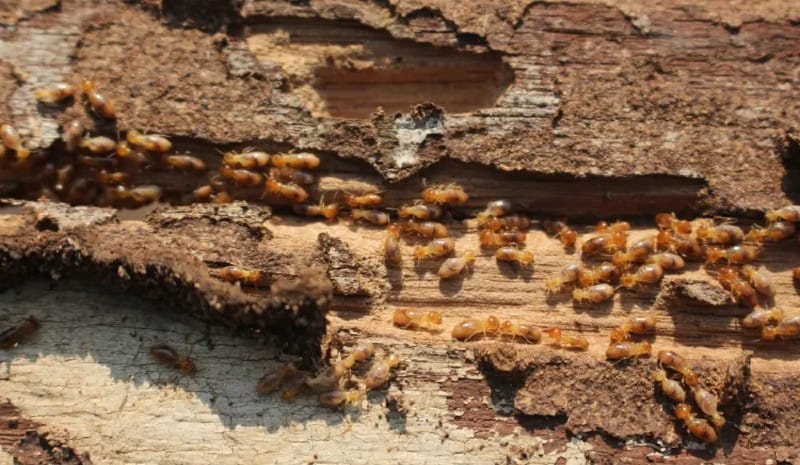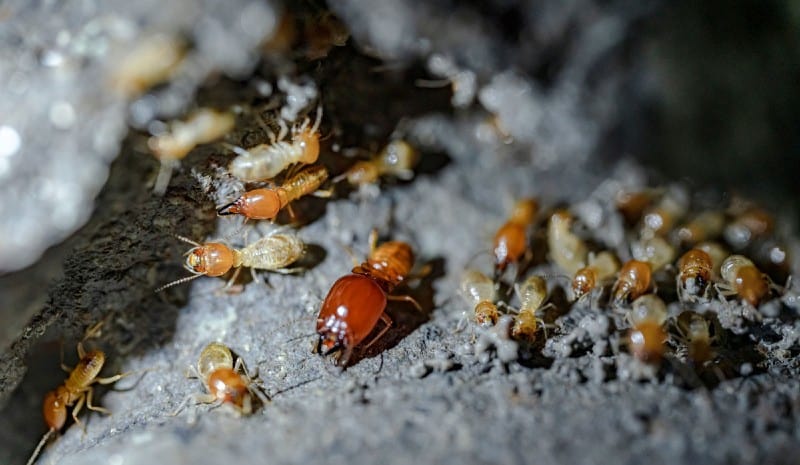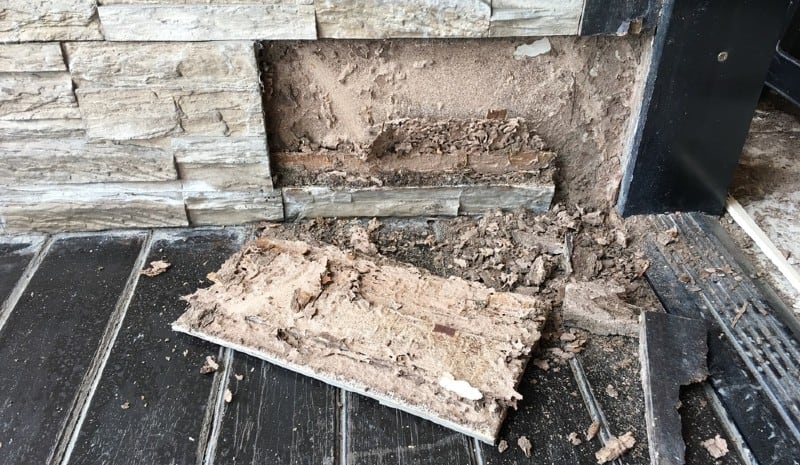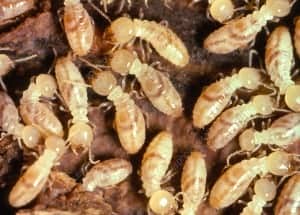What Do Subterranean Termites Eat?

Subterranean termites are known for their insatiable hunger and their diet primarily consists of cellulose, a complex carbohydrate found in plants.
Cellulose: The digestive system of subterranean termites is designed to break down cellulose. Their gut contains protozoa and bacteria that break down cellulose into simpler compounds, which can be used as a food source. However, the cellulose present in plant fibers is difficult to digest, so termites require a highly specialized diet that includes microbes to help in the fermentation process. Cellulose is a critical component of a termite’s diet, and they can cause significant damage to homes and other structures that contain wood.
Other Food Sources: While cellulose is the primary component of their diet, subterranean termites may consume other materials besides wood-based products. For instance, they may feed on debris, animal dung, and decomposing vegetation. They have even been known to consume cardboard and the paper in drywall in homes. In fact, many materials used in home construction contain cellulose and are potential food sources for termites.
To learn more about termite feeding patterns, visit The importance of understanding termite feeding habits for effective control. For information on the differences between drywood and dampwood termites, see Comparing the diets of drywood and dampwood termites. To read about the role of gut microbes in termite digestion, go to The role of gut microbes in termite digestion. For more on the importance of cellulose in termite nutrition, check out How termites benefit from cellulose breakdown. The impact of termite diet and behavior is discussed at Examining the impact of diet on termite behavior, while the modification of landscapes by termites is explored at How landscaping can help prevent termite infestation.
Cellulose
Subterranean termites are widely known for their love for cellulose. In fact, cellulose forms a significant part of their diet, and they obtain it from various sources. Cellulose is a complex carbohydrate that forms the structural component of plant cell walls and provides plants with their strength and rigidity. Some of the most common sources of cellulose for subterranean termites include wood, leaves, grass, and other plant materials.
Wood: Wood is the primary source of cellulose for subterranean termites. Their love for wood is what earns them the name ‘silent destroyer.’ These insects are notorious for causing extensive damage to people’s homes and properties by feeding on wood. They consume wood fiber by breaking down the cellulose present in the wood. Over time, as they continue to feed on the wood, they can cause serious structural damage to buildings, leading to expensive repair costs.
Leaves and grass: In addition to wood, subterranean termites also feed on leaves and grass. These insects have a unique, highly efficient digestive system that enables them to break down cellulose and extract the nutrients they need from plants. They can even consume and digest plant roots, although this is not as common as feeding on wood.
Plant materials: Subterranean termites also consume other plant materials that contain cellulose. This includes paper, cardboard, and other items made of plant fibers. These insects are attracted to areas where they can find a reliable source of cellulose, making homes and other buildings with wood components their primary target.
Other Food Sources

Subterranean termites are known for their ability to break down cellulose, but they also consume other food sources. One such source is fungus. Termites often cultivate fungus gardens within their nests, as the fungus provides an important source of food for the colony. The insects feed on the fungus and also use it to break down wood and other cellulose materials.
Another food source for subterranean termites is humus. Humus is the organic component of soil, formed from the decomposition of leaves and other plant material. Termites are known to consume humus and other forms of organic matter found in soil.
In addition to fungus and humus, subterranean termites may also consume other insects. This is especially true when the termite colony is under stress and is unable to find enough cellulose or fungus to sustain the colony. In these situations, the termites may attack and consume other insects within their environment.
Finally, subterranean termites have been known to consume artificial materials like plastic and rubber. While these materials are not a natural food source for the insects, they may still consume them if they come into contact with them. This is particularly common in urban environments where structures are made of a variety of materials beyond just wood and other forms of cellulose.
How Does Diet Affect Termite Control?
Termites are known for their seemingly insatiable appetite for cellulose, the primary component found in wood. However, subterranean termites are not limited to just wood as their food source, making it important to understand how their diet affects termite control.
Baiting: One of the most effective methods for controlling subterranean termites is through baiting. Termite bait consists of a slow-acting poison disguised as food that is specifically designed to appeal to termites. The bait is placed near termite colonies, and as they feed on the bait and bring it back to the colony, it slowly eliminates the entire colony. However, if termites have access to other food sources, they may not be as attracted to the bait, which can significantly reduce its effectiveness.
Chemical Treatments: Chemical treatments, such as soil treatments and wood treatments, can also be used to control termites. These treatments work by creating a barrier around the building or structure, repelling or killing any termites that come in contact with it. However, if termites have access to alternative food sources, they may be less likely to come into contact with the treated area, reducing the effectiveness of the treatment.
Cultural Control: In addition to baiting and chemical treatments, cultural control methods can also be used to prevent termite infestations. This includes removing any sources of moisture and fixing any leaks, as subterranean termites are attracted to moist environments. It also includes removing any wood or cellulose debris from around the building or structure. By removing these potential food sources, it can make the area less attractive to termites, reducing the risk of infestation.
Understanding the diet of subterranean termites is crucial for effective control strategies. By reducing their access to alternative food sources, baiting and chemical treatments can be more effective. Additionally, cultural control methods can be used to make the environment less appealing to termites. By taking a comprehensive approach to termite control, property owners can better protect their investment from termite damage.
Preventing Termite Damage

As the old saying goes, prevention is better than cure. This is especially true when it comes to subterranean termites. The best way to avoid termite damage is to take preventative measures. In this section, we will explore some of the most effective strategies for preventing termite damage to your home.
Home Modifications
One of the main ways to prevent termite damage is to make modifications to the home. Start by removing any excess wood or cellulose debris from around your property. This could include old tree stumps, wooden scraps, or other pieces of wood that lie unused. Subterranean termites feed on cellulose found in wood, paper, and cardboard, so removing these materials from the vicinity of your home is a vital first step.
Additionally, ensure that any exposed wood in and around your home is treated with a termiticide. This offers protection against termites for several years and is an essential preventative measure. While this won’t provide complete protection, it can definitely help to reduce the risk of an infestation. It’s also a good idea to regularly check for any dampness that could be attracting termites and take steps to fix it immediately.
Pest Inspections
Regular pest inspections are the cornerstone of effective termite prevention. Hiring a qualified termite inspection professional at least once a year is a great way to detect any early signs of an infestation. This can help to prevent an infestation from growing and causing costly damages to your property. Early detection is key when it comes to termites since they can often go unnoticed until serious damage is done.
During a termite inspection, the inspector will look for signs of an active infestation and evaluate any potential risk factors. This could include things like finding termite mud tubes, damaged wood, or swarming termites. Based on their findings, they may recommend a course of action to prevent an infestation or treat any current problems.
Conclusion
In conclusion, understanding the diet of subterranean termites is crucial for effective termite control and prevention. These wood-destroying pests rely heavily on cellulose, which is found in various sources such as wood, paper, and plant materials. However, they are also known to consume other food sources such as fungi and bacteria.
Controlling termite infestations through baiting, chemical treatments, and cultural control methods can be effective, but prevention is the key. Regular inspections and home modifications can help limit the opportunities for termites to invade and cause damage.
It’s important to note that termite damage can be devastating and costly, with repairs potentially reaching thousands of dollars. Therefore, taking proactive measures to prevent termite infestations is essential for protecting your home and property.
In conclusion, education and understanding about subterranean termites, their diet, and habits are essential for effective termite control. By taking preventative measures and staying vigilant, we can protect our homes and prevent costly termite damage.
Frequently Asked Questions
What is the diet of subterranean termites?
Subterranean termites feed mainly on cellulose, which is found in wood and other plant materials.
Do termites eat anything other than wood?
Yes, termites also feed on fungi, animal feces, and other organic materials that contain cellulose.
How much wood can a termite colony eat in a day?
A mature termite colony can consume anywhere from a few ounces to several pounds of wood per day, depending on the species and size of the colony.
What are the signs of termite damage?
The most common signs of termite damage include blistered wood, sagging floors or ceilings, and mud tubes along the foundation of the house.
How do you prevent termites from entering your home?
You can prevent termites from entering your home by sealing all foundation cracks and gaps, removing any decaying wood or wood debris from the yard, and reducing moisture levels in crawlspaces and attics.
Can termites survive without water?
No, termites require a source of moisture to survive
How do you treat a termite infestation?
Treatment options for termite infestations include baiting systems, chemical treatments, and cultural control measures, such as removing food sources and reducing moisture levels.
Are all termites harmful to structures?
No, not all termite species cause damage to structures. However, many species are classified as pests because of the damage they can cause.
Can termite damage be repaired?
Yes, termite damage can be repaired by replacing the damaged wood and treating the area with protective chemicals to prevent future infestations.
What should I do if I suspect a termite infestation?
If you suspect a termite infestation, it is important to contact a pest control professional immediately to assess the situation and determine the best course of action.

